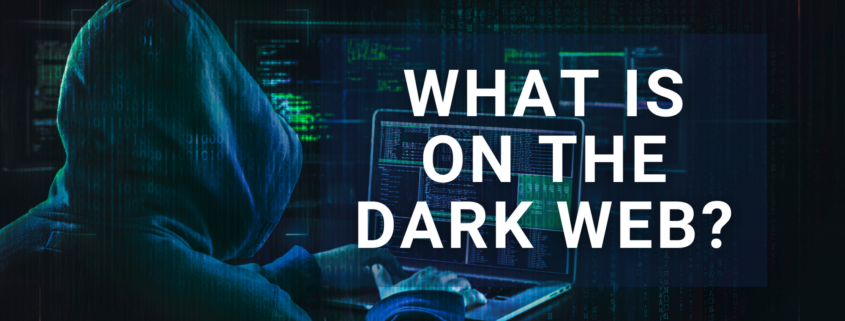What is on the Dark Web?
The Dark Web is an area of the internet that is not visible to search engines, like Google and Bing. Just like the internet we see and use every day, also called the surface web, there are a large number of web pages offering information, products & services, and even peer-to-peer platforms on the Dark Web.
In fact, the deep web & dark web are estimated to be 500 to 550 times larger than the surface web.
How Do We Get On The Dark Web?
The dark web browser thrives off of anonymity. A Browser Anonymizer is like using Google Chrome or Internet Explorer in incognito mode on steroids. It is needed to access the dark web in order to keep all users anonymous.
One of the more popular browsers is called Tor. Tor’s browser connects to Tor’s network connects randomly to 3 different publicly listed entry nodes anywhere on Earth. This makes it extremely difficult to find the origin of users.
In other words, when you search for something on Tor’s browser it will carry out your search on the dark web anonymously.
Through Tor, user’s information cannot be traced back to a physical location. If someone tries to track a user on Tor, it will show the random locations that it connected to across the world rather than the actual location of the user that is being tracked.
Who puts the information on the Dark Web?
Technically, anyone with a dark web browser can put information on the dark net.
Generally, most of the activity comes from hackers. Hackers carry out phishing, ransomware, keylogger, and other cyberattacks with the intention of selling that data to the highest bidder. It is estimated that a ransomware attack will happen every 11 seconds in 2021.
Once these cyber criminals gain access to company credentials, it can lead to an enormous data breach. These have the largest impact on the public with an average of 25,000+ compromised records per data breach.
Unfortunately, mistakes do happen. Credentials can become compromised due to a lack of awareness and accidentally posting that information on social media or another peer-to-peer site. In these cases, malicious individuals crawling the surface web will find and put that information on the dark web for their own gain.
Types of information found on the Dark Web:
Virtually any information that can be found on a computer or on the web can be stolen and displayed one way or another on the dark web. Here is a list of the most common data found:
- Bank Account Credentials
- Social Security Numbers
- Social Media Credentials
- Store Credit Cards
- Encrypted Data
- Passwords of all kinds
- Medical Records
- Email Addresses
Where does that information come from?
There are four main ways in which your credentials and data can be stolen:
- Keylogging or Phishing: Hackers find ways to get you to enter your information on a fictitious website or to download software designed to steal personally identifiable information (PII).
- 3rd Party Breach: When the compromised data was exposed as part of a company’s internal data breach or on a 3rd party website
- Malicious/Doxed: This occurs when the compromised data was intentionally broadcast to expose personal identifiable information (PII)
- Accidental Exposure: The compromised data was accidentally shared on social media, peer-to-peer sites, or other websites
What happens if your information is on the Dark Web?
It is important to understand that if you find your data on the dark web, there is little you can do to remove it.
That being said, just because you find compromised credentials online does not mean that someone has started to use those credentials yet.
Therefore, time is of the essence and there is a chance that a data breach can be avoided.
The best form of action is to follow pre-established processes and procedures to reset passwords, backup data, etc.
This helps to both minimize and understand the extent and impact of the data breach.
Prevent your information from showing up on the Dark Web
Regularly held awareness and training sessions are still one of the best ways to prevent credentials from being compromised.
Employees are on the frontline of cyberattacks and need to know what red flags to look out for to avoid phishing attacks, emails with malicious links, etc.
It is commonplace to receive cybersecurity training when going through onboarding training. Once completed, they never receive another cybersecurity training or update afterward.
As a result, this leaves employees vulnerable and unaware of new cyberattack methods or messaging.
Ensure 100% compliance with industry regulations
Remaining compliant is a wonderful way to help prevent data breaches.
Being compliant avoids adding insult to injury when a data breach is unavoidable. Avoiding fees and fines after a damaging data breach can be the difference between going out of business and recovering.
Data-Tech offers Compliance Management services to ensure that your company is compliant and protected from cyberthreats.
Monthly Live Dark Web Searches
It can take months to find evidence of a cyberattack or data breach. With Data-Tech’s Dark Web Monitoring subscription, we are conducting monthly searches, we can notice data breaches faster and take appropriate action within a reasonable amount of time.
Conducting regular live searches with proper tracking will establish trends. Once trends are established, it is easier to track irregularities. Tracking for irregularities will optimize and become more accurate over time.
Personal Email Monitoring
It is common for employees to utilize their personal emails to send information or files to their work computers and vice-versa.
Therefore, in an effort to further protect companies and their employees, Data-Tech can track up to 10 personal emails along with continuous monitoring and monthly scans.
Continuous Monitoring & Reporting
Be alerted as soon as compromised credentials are found.
Take action before a hacker has the chance to sell your information to other cyber criminals.
How to find compromised credentials:
Dark Web Monitoring enables companies to shine a light onto the dark web. We will determine which credentials have been compromised and take the appropriate action to prevent a data breach from occurring.
75% of data breaches are reported from a 3rd party, like law enforcement. This usually happens months after the original breach allowing ample time for hackers to find buyers on the dark web.
Utilizing Data-Tech’s Dark Web Monitoring services allows you to conduct regular live searches. This greatly reduces the time it takes to become aware of a hack and potential data breach.
Get your FREE Dark Web Scan and get your results within 24 hours. Find out if you need to take immediate action to prevent a data breach or further damage to your company’s data.
Data-Tech is an award winning Managed IT Services firm in Tampa, FL. Learn more about Data-Tech accomplishments and our managed services.




